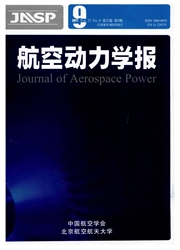

 中文摘要:
中文摘要:
采用数值模拟的方法,研究了主流跨声速条件下,高压涡轮中平面叶尖上气膜冷却的流动和传热特性.在不带冷却的平面叶尖上,激波在端壁和叶尖表面来回反射,从叶片中部到尾缘,叶尖表面传热系数呈现条带状分布.采用气膜冷却方法后,冷却气体使得叶尖间隙内的流体减速,激波和叶尖上表面传热系数分布的条带结构不明显.冷却气体覆盖了冷却孔下游的区域,当冷却孔进口和叶栅进口总压比从0.7增大到1.0时,叶尖平均气膜冷却效率从18.7%下降到11.5%.和不采用气膜冷却的平面叶尖相比,当气膜孔进口和叶栅进口总压比为0.9时,叶尖平均表面传热系数增加了16.9%,传热量降低了8.7%.
 英文摘要:
英文摘要:
Computational fluid dynamics (CFD) was used to investigate the aerothermal performance of tip leakage flow of a flat tip in a transonic high pressure turbine cascade. The effects of tip film cooling were considered. For the flat tip without tip cooling, shock waves were reflected between the endwall and the blade tip within the tip gap. As a result, the sur face heat transfer coefficient is distributed as stripe pattern on the tip surface from blade mid chord to the trailing edge. The injection of the coolant has a significant effect on the flow patterns within the tip gap. The coolant reduces the velocity of the flow within the tip gap. As a result, oblique shock waves are no longer obviously observed. The coolant covers the areas downstream the cooling holes. When increasing the inlet stagnation total pressure ratio of the coolant to the main flow from 0.7 to 1.0, the average film cooling effectiveness on the tip varies from 18.7% to 11.5%. Compared to the uncooled flat tip, at the inlet stagnation total pressure ratio of 0.9, the average surface heat transfer coefficient on the cooled flat tip increases by 16.9%, and the heat flux of the tip reduces by 8.7%.
 同期刊论文项目
同期刊论文项目
 同项目期刊论文
同项目期刊论文
 期刊信息
期刊信息
